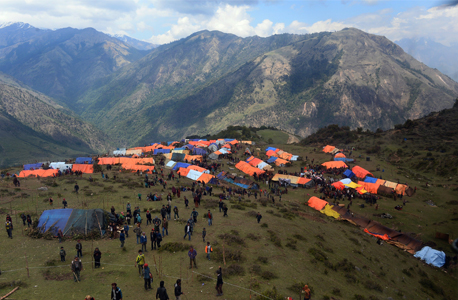
Architecture and disaster: emergency shelter in Nepal
Architecture and disaster: emergency shelter in Nepal
Share
Basic tarpaulin sheeting housing the displaced in Nepal. Image via The Guardian.
The deadly earthquake that hit Nepal last week claimed over 7200 lives, injured 14,000 and left over 600,000 homes destroyed or damaged.
Since the earthquake, many Nepalese have been sleeping in the open, afraid to return to their homes because of powerful aftershocks. Public spaces like Kathmandu’s main sports stadium and golf course have become temporary villages, filled with people in makeshift tents. Nepal’s monsoon season is also soon approaching, and there is a growing need for more tents, water, food and medicine.
Basic tarpaulin sheeting is being provided for survivors to make tents; however, locals fear that tents are unable to resist the strong monsoon winds and rains, and are looking for longer-term solutions. Although they provide shelter, tents are far from the ideal solution. For instance, in the aftermath of the Indian Ocean tsunami, entire villages reportedly lived under tarpaulin tents for over two years while they awaited their allotted houses.
With the huge housing and infrastructure shortage, design professionals and the construction industry have a significant role in maintaining the health and safety of the environment and in providing disaster management.
One of the main consequences of disaster is prolonged displacement. Five years after Hurricane Katrina, it was reported that less than half of the New Orleans residents had returned to their homes. But some residents returned too early, unaware that there were still health and safety risks involved with living in damaged homes. A common complaint was the ‘Katrina cough’, which was due to the mix of high temperatures and flooding in homes.
Proper housing is crucial in preventing the spread of illness and disease. As a result of unsanitary living conditions, Haiti suffered the worst cholera outbreak in recent history. In the aftermath of its 2010 earthquake, Haiti’s cholera outbreak killed another 8000 people, and hundreds of thousands were hospitalised.
But disasters do not just cause short-term health problems. Experts say that the more people are exposed to stressors, the more they are at risk of developing long-term mental illness. In other words, the quicker people are able to safely return to their homes, the healthier they will be.
As such, the international architecture community is pushing for urgent assistance in long-term and safe reconstruction.
The Royal Institute of British Architects together with the international Red Cross and Red Crescent Societies are calling for people with local or regional experience to provide technical expertise in the efforts to rebuild the destruction.
Local Australian organisations such as the Architects without Frontiers (AWF) have also teamed up with international groups like Paris-based Architecture & Développement, to provide technical support and to help plan the long-term rebuilding process.
So far, a number of notable architects and groups have contributed their efforts towards developing shelter and housing solutions.
Japanese architect Shigeru Ban is planning to build tents to house medical personnel and supplies in Nepal. The architect is known for his innovative use of materials in disaster situations, particularly recycled cardboard tubes, which can be used to quickly and efficiently build housing for disaster victims.
After the 2011 earthquake in Onagawa, Japan, Shigeru Ban developed a temporary housing complex that could be built from paper tubes and shipping containers. Each three-storey complex provided 188 homes, and could be constructed cheaply and quickly. In another scenario, Ban developed a prototype house for tsunami survivors that could be built from earth blocks, timber and coconut shells.
Swedish furniture giant IKEA has also contributed €3 million (AU$4.5 million) toward providing emergency relief in Nepal. Earlier this year, IKEA designed a flat-pack refugee shelter, capable of housing five people. The shelter can be assembled on-site without additional tools, and includes solar power and a lamp.
One of the key ways that building professionals can provide assistance is in providing safety assessments of damaged buildings. This allows residents to quickly and safely return to their homes, and resources can then be focused on food and other necessities, rather than shelters and temporary housing.
Another crucial factor in the initial relief efforts will be finding effective solutions and systems for owner-driven reconstruction. The success of such efforts will depend largely on how effectively the international aid community can engage with local people, local authorities and local realities.
Architectural aid organisations such as Article 25, Architecture & Développement and Habitat for Humanity seek to equip architects with the guidance and tools they need, to prepare them for the risks they face, and to help them protect the communities they serve.
To find out how you can help in the relief efforts, or to donate, please visit Habitat for Humanity.
You Might also Like


















